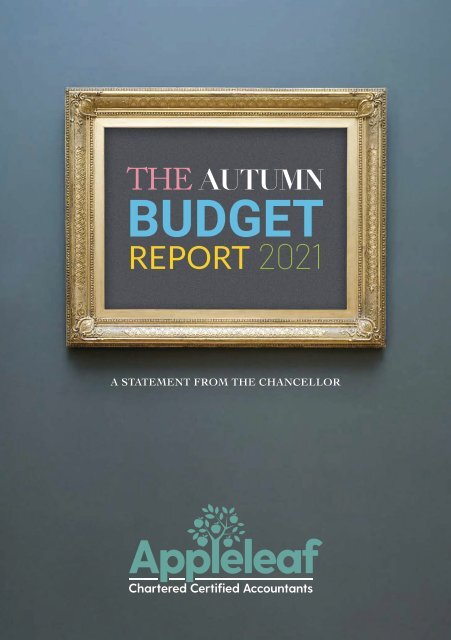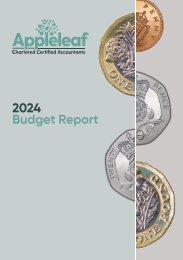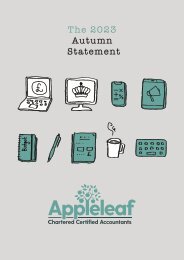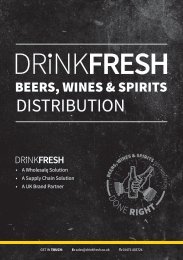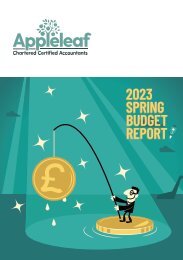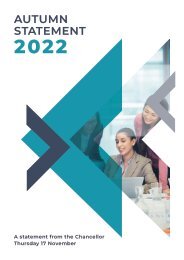Appleleaf Accountancy Autumn Budget Document
The Chancellor Rishi Sunak presented his third Budget on 27 October 2021. In his speech he set out the plans to “build back better” with ambitions to level up and reduce regional inequality.
The Chancellor Rishi Sunak presented his third Budget on 27 October 2021. In his speech he set out the plans to “build back better” with ambitions to level up and reduce regional inequality.
You also want an ePaper? Increase the reach of your titles
YUMPU automatically turns print PDFs into web optimized ePapers that Google loves.
THE AUTUMN<br />
BUDGET<br />
REPORT 2021<br />
A STATEMENT FROM THE CHANCELLOR
AUTUMN BUDGET 2021<br />
The Chancellor Rishi Sunak presented his third <strong>Budget</strong> on 27 October 2021. In<br />
his speech he set out the plans to “build back better” with ambitions to level up<br />
and reduce regional inequality.<br />
Main <strong>Budget</strong> proposals<br />
Tax measures include:<br />
• a new temporary business rates relief in England<br />
for eligible retail, hospitality and leisure properties<br />
for 2022/23<br />
• a change in the earliest age from which most<br />
pension savers can access their pension savings<br />
without incurring a tax charge. From April 2028 this<br />
will rise to 57<br />
• the retention of the £1 million annual investment<br />
allowance until 31 March 2023<br />
• individuals disposing of UK property on or after<br />
27 October 2021 now have a 60 day CGT reporting<br />
and payment deadline, following the completion of<br />
the disposal.<br />
Other measures include:<br />
• a complete overhaul of alcohol duties that will see<br />
drinks taxed on their strength<br />
• the cancellation of the previously announced rise in<br />
fuel duties<br />
• pubs supported with a reduction in draught beer<br />
and cider duty<br />
• increases in the National Living Wage and the<br />
National Minimum Wage rates<br />
• an ultra-long-haul band of air passenger<br />
duty introduced.<br />
Some <strong>Budget</strong> proposals may be subject to amendment<br />
in the Finance Bill 2021-22. Should you need any<br />
further help or support please contact us.<br />
Contents<br />
Page<br />
Personal Tax 2 - 4<br />
Employment 5 - 6<br />
Business 7 - 10<br />
Capital Taxes 11 - 12<br />
Other Matters 13 - 14<br />
Rates and Allowances 15 - 16<br />
Welcome Page 1
PERSONAL TAX<br />
The personal allowance<br />
The personal allowance is currently £12,570. The<br />
Chancellor announced in the March 2021 <strong>Budget</strong> that<br />
the personal allowance will be frozen at £12,570 for the<br />
tax years 2022/23 to 2025/26.<br />
There is a reduction in the personal allowance for<br />
those with ‘adjusted net income’ over £100,000. The<br />
reduction is £1 for every £2 of income above £100,000.<br />
So there is no personal allowance where adjusted net<br />
income exceeds £125,140.<br />
The marriage allowance<br />
The marriage allowance permits certain couples,<br />
where neither party pays tax in the tax year at a rate<br />
other than the basic rate, to transfer £1,260 of their<br />
personal allowance to their spouse or civil partner.<br />
Comment<br />
The marriage allowance reduces the recipient’s<br />
tax bill by up to approximately £250 a year. To<br />
benefit from the marriage allowance one spouse<br />
or civil partner must normally have no income or<br />
income below the personal allowance for the year.<br />
The marriage allowance was first introduced for<br />
2015/16 and there are couples who are entitled<br />
to claim but have not yet done so. It is possible<br />
to claim for all years back to 2017/18 where the<br />
entitlement conditions are met. The total tax<br />
saving for all years up until 2021/22 could be over<br />
£1,000. A claim for 2017/18 will need to be made by<br />
5 April 2022.<br />
Tax bands and rates<br />
The basic rate of tax is 20%. In 2021/22 the band<br />
of income taxable at this rate is £37,700 so that the<br />
threshold at which the 40% band applies is £50,270 for<br />
those who are entitled to the full personal allowance.<br />
At Spring <strong>Budget</strong> 2021, the Chancellor announced that<br />
the basic rate band will be frozen at £37,700 for the<br />
tax years 2022/23 to 2025/26. The National Insurance<br />
contributions Upper Earnings Limit and Upper Profits<br />
Limit will remain aligned to the higher rate threshold<br />
at £50,270 for these years.<br />
Individuals pay tax at 45% on their income over<br />
£150,000.<br />
Page 2<br />
Personal Tax
Scottish residents<br />
The tax on income (other than savings and dividend<br />
income) is different, for taxpayers who are resident<br />
in Scotland, from that paid by taxpayers resident<br />
elsewhere in the UK. The Scottish income tax rates and<br />
bands apply to income such as employment income,<br />
self-employed trade profits and property income.<br />
In 2021/22 there are five income tax rates which range<br />
between 19% and 46%. Scottish taxpayers are entitled<br />
to the same personal allowance as individuals in the<br />
rest of the UK. The two higher rates are 41% and 46%<br />
rather than the 40% and 45% rates that apply to such<br />
income for other UK residents. Currently the 41%<br />
band applies to income over £43,662 for those who are<br />
entitled to the full personal allowance. The 46% rate<br />
applies to income over £150,000.<br />
The Scottish Government will announce the Scottish<br />
income tax rates and bands for 2022/23 in the Scottish<br />
<strong>Budget</strong> on 9 December.<br />
Welsh residents<br />
From April 2019, the Welsh Government has had the<br />
right to vary the rates of income tax payable by Welsh<br />
taxpayers (other than tax on savings and dividend<br />
income). The UK government has reduced each of the<br />
three rates of income tax paid by Welsh taxpayers by<br />
10 pence. For 2021/22 the Welsh Government has set<br />
the Welsh rate of income tax at 10 pence which has<br />
been added to the reduced rates. This means the tax<br />
payable by Welsh taxpayers is the same as that payable<br />
by English and Northern Irish taxpayers.<br />
The Welsh Government will publish its Draft <strong>Budget</strong><br />
for 2022/23 on 20 December.<br />
Tax on savings income<br />
Savings income is income such as bank and building<br />
society interest.<br />
The Savings Allowance applies to savings income<br />
and the available allowance in a tax year depends on<br />
the individual’s marginal rate of income tax. Broadly,<br />
individuals taxed at up to the basic rate of tax have<br />
an allowance of £1,000. For higher rate taxpayers the<br />
allowance is £500. No allowance is due to additional<br />
rate taxpayers.<br />
Some individuals qualify for a 0% starting rate of tax<br />
on savings income up to £5,000. However, the rate is<br />
not available if taxable non-savings income (broadly<br />
earnings, pensions, trading profits and property<br />
income, less allocated allowances and reliefs) exceeds<br />
£5,000.<br />
Tax on dividends<br />
The first £2,000 of dividends is chargeable to tax at 0%<br />
(the Dividend Allowance). Dividends received above<br />
the allowance are taxed at the following rates for<br />
2021/22:<br />
• 7.5% for basic rate taxpayers<br />
• 32.5% for higher rate taxpayers<br />
• 38.1% for additional rate taxpayers.<br />
In September 2021 the government announced<br />
an increase to the rates of dividend tax by 1.25%<br />
from 6 April 2022 to help fund the new planned<br />
investment in health and social care. The new rates<br />
will therefore be 8.75% for basic rate taxpayers, 33.75%<br />
for higher rate taxpayers and 39.35% for additional<br />
rate taxpayers.<br />
Dividends within the allowance still count towards<br />
an individual’s basic or higher rate band and so may<br />
affect the rate of tax paid on dividends above the<br />
Dividend Allowance.<br />
To determine which tax band dividends fall into,<br />
dividends are treated as the last type of income to<br />
be taxed.<br />
Comment<br />
Dividends on shares held in ISAs and pension<br />
schemes are not subject to dividend tax and thus<br />
will not be affected by the increase in rates.<br />
Green National Savings and<br />
Investment (NS&I) product<br />
In the Spring <strong>Budget</strong> 2021 the government announced<br />
a green retail savings product through NS&I. The<br />
Bonds are now available to buy online and offer savers<br />
a chance to support green projects at a fixed rate<br />
of 0.65% pa over a three-year term. The Bonds are<br />
available to those aged 16 or over, with a minimum<br />
Personal Tax Page 3
investment of £100 and a maximum limit of £100,000<br />
per person. The interest is taxable in the tax year the<br />
Bond matures.<br />
The UK’s inaugural sovereign green bond (or ‘green<br />
gilt’) was launched in September 2021, and was<br />
followed by a second issuance in October 2021. They<br />
are the first sovereign green retail product of their kind<br />
in the world.<br />
Universal Credit<br />
The Universal Credit taper rate is reduced from 63% to<br />
55%, meaning Universal Credit claimants will be able<br />
to keep an additional 8p for every £1 of net income<br />
they earn.<br />
Pensions - Scheme Pays<br />
Although there are no limits to how much an<br />
individual can save or accrue in a registered pension<br />
scheme, there is an overall limit on the amount of an<br />
individual’s tax-relieved annual pension savings or<br />
accrual which includes employer contributions. This<br />
is known as the annual allowance and the standard<br />
annual allowance is currently £40,000, but in some<br />
circumstances this is reduced, with the maximum<br />
reduction taking it down to £4,000.<br />
An individual’s unused annual allowance from the<br />
three previous tax years can be carried forward<br />
and added to the annual allowance. However, if the<br />
individual’s pension savings for the tax year exceed<br />
their annual allowance, the annual allowance tax<br />
charge is applied to the excess.<br />
Although this tax liability would normally be the<br />
individual's liability it is possible for them to elect for<br />
the pension scheme administrator to be jointly liable.<br />
Where an individual has inputted more than £40,000<br />
and their annual allowance charge exceeds £2,000 the<br />
individual can request that their pension company<br />
pays the charge for them in return for an equivalent<br />
reduction in the value of their pension pot. This is<br />
called mandatory Scheme Pays.<br />
Increase to the normal minimum<br />
pension age<br />
The current earliest age at which most pension savers<br />
can access their pension savings without incurring a<br />
tax charge is age 55. From April 2028 this earliest age<br />
will rise to 57.<br />
From April 2022 there will be a change to the rules<br />
for certain pension schemes to remove anomalies<br />
where the tax charge has arisen due to a retrospective<br />
change of facts, the tax charge is £2,000 or more and<br />
the individual requests the pension scheme pays the<br />
amount. This measure applies retrospectively from<br />
6 April 2016.<br />
This measure will affect individuals born after<br />
5 April 1973 whose earliest date to access their pension<br />
benefits will see a two-year delay to those born on or<br />
before that date.<br />
Page 4<br />
Personal Tax
EMPLOYMENT<br />
National Insurance Contributions<br />
(NICs)<br />
In September 2021 the government published its<br />
proposals for new investment in health and social care<br />
in England. The proposals will lead to a permanent<br />
increase in spending not only in England but also by<br />
the devolved governments. To fund the investment the<br />
government will introduce a UK-wide 1.25% Health<br />
and Social Care Levy based on the NIC system but ring<br />
fenced for health and social care.<br />
The Health and Social Care Levy Act provides for<br />
a temporary 1.25% increase to both the main and<br />
additional rates of Class 1, Class 1A, Class 1B and Class<br />
4 NICs for 2022/23. From April 2023 onwards, the NIC<br />
rates will decrease back to 2021/22 levels and will be<br />
replaced by a new 1.25% Health and Social Care Levy.<br />
Broadly, the new Health and Social Care Levy<br />
will be subject to the same reliefs, thresholds and<br />
requirements as NIC. However the Levy (as opposed<br />
to the temporary increase in NICs for 2022/23) will also<br />
apply to those above State Pension age who are still in<br />
employment.<br />
Existing reliefs for NICs to support employers will<br />
apply to the Levy. Companies employing apprentices<br />
under the age of 25, all people under the age of 21,<br />
veterans and employers in Freeports will not pay the<br />
Levy for these employees as long as their yearly gross<br />
earnings are less than £50,270, or £25,000 for new<br />
Freeport employees.<br />
The Employment Allowance, which reduces<br />
employers’ Class 1 NICs by up to £4,000, will also be<br />
available for the employers’ liability to the Levy.<br />
Comment<br />
A novel aspect of the Levy is the application to<br />
employees above State Pension age. This does<br />
not apply in respect of the temporary increase<br />
for 2022/23. The Levy will not apply to Class 2 (a<br />
flat rate paid by many self-employed) and Class 3<br />
(voluntary contributions for taxpayers to fill gaps in<br />
their contribution records).<br />
The main burden of the 1.25% increase falls on the<br />
collective shoulders of the employer and employee<br />
as each will have higher contributions to make.<br />
Those with property income will be relieved that<br />
they are not being included in the Levy.<br />
National Living Wage (NLW) and<br />
National Minimum Wage (NMW)<br />
Following the recommendations of the independent<br />
Low Pay Commission, the government will increase<br />
the NLW for individuals aged 23 and over by 6.6%<br />
from 1 April 2022. The government has also accepted<br />
the recommendations for the other NMW rates to<br />
be increased.<br />
Employment Page 5
From 1 April 2022, the hourly rates of NLW and NMW<br />
will be:<br />
• £9.50 for those 23 years old and over<br />
• £9.18 for 21-22 year olds<br />
• £6.83 for 18-20 year olds<br />
• £4.81 for 16-17 year olds<br />
• £4.81 apprentice rate for apprentices under<br />
19, and those 19 and over in their first year<br />
of apprenticeship.<br />
Comment<br />
In total, the annual gross earnings of a full-time<br />
worker on the NLW will have increased by over<br />
£5,000 since its introduction in April 2016.<br />
Power to make temporary<br />
modifications of taxation of<br />
employment income<br />
This will allow HM Treasury, under ministerial<br />
direction, to make regulations to make temporary<br />
modifications to existing legislation for a period of up<br />
to two tax years in the event of a disaster or emergency<br />
of national significance as determined by HM<br />
Treasury. This will enable the government to support<br />
taxpayers, for example by:<br />
• exempting benefits in kind of a specified description<br />
from income tax where appropriate<br />
• changing the qualifying conditions for exemptions<br />
on benefits in kind<br />
• exempting specified reimbursements from the<br />
charge to income tax<br />
• providing relief for specified expenses.<br />
This will have effect on and after the date of Royal<br />
Assent to the Finance Bill 2021-22.<br />
Page 6<br />
Employment
BUSINESS<br />
Making Tax Digital for income tax<br />
The Making Tax Digital (MTD) regime is based<br />
on businesses being required to maintain their<br />
accounting records in a specified digital format and<br />
submit extracts from those records regularly to HMRC.<br />
It had been expected that sole trader businesses and<br />
landlords with business income of more than £10,000<br />
per annum would be required to enter the MTD<br />
regime for income tax purposes from 6 April 2023.<br />
However, HMRC recently announced that this will be<br />
deferred until 6 April 2024. Early adoption of digital<br />
record keeping and voluntary submission of MTD for<br />
income tax data remains possible.<br />
Following the deferral for sole trader businesses and<br />
landlords, general partnerships will not be required<br />
to comply with MTD for income tax until 6 April 2025<br />
and the date other types of partnerships (for example<br />
limited liability partnerships) will be required to<br />
comply will be confirmed in the future.<br />
HMRC has also confirmed that the new system of<br />
penalties for the late filing and late payment of tax for<br />
income tax self assessment will be aligned with when a<br />
taxpayer becomes mandated into MTD for income tax.<br />
For individuals without trade or property income or<br />
otherwise exempt from MTD for income tax, the new<br />
penalty regime will apply to their income tax affairs<br />
from 6 April 2025.<br />
MTD for corporation tax<br />
HMRC has previously announced that MTD for<br />
corporation tax will not be mandated before 2026.<br />
Accounting periods that are not<br />
aligned to tax years<br />
Aligned to the revised start date for MTD for income<br />
tax, changes will be made to simplify the rules<br />
under which trading profits made by self-employed<br />
individuals and partnerships are allocated to tax years.<br />
The changes mainly affect unincorporated businesses<br />
that do not draw up annual accounts to 31 March or 5<br />
April. The transition to the new rules will take place in<br />
the 2023/24 tax year and the new rules will come into<br />
force from 6 April 2024.<br />
Affected self-employed individuals and partnerships<br />
may retain their existing accounting period but the<br />
trade profit or loss that they report to HMRC for a tax<br />
year will become the profit or loss arising in the tax<br />
year itself, regardless of the chosen accounting date.<br />
Broadly, this will require apportionment of accounting<br />
profits into the tax years in which they arise.<br />
Business Page 7
Example<br />
A business prepares accounts to 30 June every<br />
year. Currently, income tax calculations for<br />
2024/25 would be wholly based on the profits for<br />
the year ended 30 June 2024. The change will<br />
mean that the income tax calculations for 2024/25<br />
will be based on 3/12 of the profits for the year<br />
ended 30 June 2024 and 9/12 of the profits for the<br />
year ended 30 June 2025.<br />
The £1 million allowance will now be retained until<br />
31 March 2023.<br />
Transitional rules will apply to accounting periods that<br />
span 1 April 2023.<br />
This change will potentially accelerate when business<br />
profits are taxed but transitional adjustments in<br />
2023/24 are designed to ease any cashflow impact of<br />
the change.<br />
Comment<br />
An estimated 93% of sole traders and 67% of<br />
trading partnerships draw up their accounts to<br />
31 March or 5 April and thus the current rules are<br />
straightforward and the proposed changes will not<br />
affect them. Those with a different year end might<br />
wish to consider changing their accounting year<br />
end to simplify compliance with tax rules.<br />
Corporation tax rates<br />
The main rate of corporation tax is currently 19%. In<br />
the Spring <strong>Budget</strong> 2021, the Chancellor announced<br />
the rate would remain at 19% until 1 April 2023 but<br />
the rate will then increase to 25% for companies with<br />
profits over £250,000. The 19% rate will become a<br />
small profits rate payable by companies with profits<br />
of £50,000 or less. Companies with profits between<br />
£50,001 and £250,000 will pay tax at the main rate<br />
reduced by a marginal relief, providing a gradual<br />
increase in the effective corporation tax rate.<br />
Capital allowances<br />
Plant and machinery<br />
Most corporate and unincorporated businesses<br />
are able to utilise a £200,000 annual investment<br />
allowance (AIA) to claim 100% tax relief on their<br />
qualifying expenditure on plant and machinery. The<br />
allowance was temporarily increased to £1 million for<br />
expenditure incurred on or after 1 January 2019 and<br />
was due to revert back to £200,000 from 1 January 2022.<br />
For companies, this aligns the end of the temporary<br />
AIA with the end of the ‘super-deductions’ as<br />
announced by the government in Spring <strong>Budget</strong> 2021.<br />
A reminder of super-deductions<br />
Between 1 April 2021 and 31 March 2023,<br />
companies investing in qualifying new plant and<br />
machinery are able to benefit from new capital<br />
allowances, termed ‘super-deductions’ or ‘first year<br />
allowances’, as follows:<br />
• a super-deduction of 130% can be claimed on<br />
most new plant and machinery investments that<br />
ordinarily qualify for the 18% main rate writing<br />
down allowances<br />
• a first year allowance of 50% can be claimed on<br />
most new plant and machinery investments that<br />
ordinarily qualify for the 6% special rate writing<br />
down allowances.<br />
These reliefs are not available for unincorporated<br />
businesses.<br />
Page 8<br />
Business
Comment<br />
Businesses incurring expenditure on plant and<br />
machinery should carefully consider the timing of<br />
their acquisitions to optimise their cashflow. In<br />
2023 the tax relief rules for expenditure on plant<br />
and machinery will change and for companies the<br />
percentage corporation tax relief saving on the<br />
expenditure may change as well.<br />
Structures and Buildings<br />
A Structures and Buildings Allowance (SBA) was<br />
introduced with effect from 29 October 2018 to<br />
relieve costs for new structures and buildings used<br />
for qualifying purposes. A business must hold an<br />
allowance statement containing certain information to<br />
be eligible to claim SBA. Minor changes will be made<br />
to the allowance statement requirements to clarify the<br />
information required to be kept.<br />
Annual Tax on Enveloped Dwellings<br />
The Annual Tax on Enveloped Dwellings (ATED)<br />
charges increase automatically each year in line with<br />
inflation. The ATED annual charges will rise by 3.1%<br />
from 1 April 2022 in line with the September 2021<br />
Consumer Price Index.<br />
Residential Property Developer<br />
Tax<br />
A new tax will be applied from 1 April 2022 on<br />
company profits derived from UK residential property<br />
development. The tax will be charged at 4% on profits<br />
exceeding an annual allowance of £25 million. For<br />
companies that are part of a group, the £25 million<br />
allowance will be allocated by the group between<br />
its companies.<br />
Cultural relief<br />
The government has announced that it will<br />
temporarily increase cultural tax reliefs for theatres,<br />
orchestras, museums and galleries across the UK<br />
from 27 October 2021 to 31 March 2024, increasing the<br />
relief organisations can claim as they invest in new<br />
productions and exhibitions.<br />
Changes will also be introduced to better target the<br />
cultural reliefs and ensure that they continue to<br />
be safeguarded from abuse. These will apply from<br />
1 April 2022.<br />
Research and Development relief<br />
reform<br />
Research and Development (R&D) tax reliefs for<br />
companies will be reformed to:<br />
• support modern research methods by expanding<br />
qualifying expenditure to include data and cloud<br />
costs<br />
• more effectively capture the benefits of R&D funded<br />
by the reliefs through refocusing support towards<br />
innovation in the UK<br />
• target abuse and improve compliance.<br />
These changes will take effect from April 2023.<br />
Cross-border group relief<br />
Following the UK’s exit from the European Union<br />
(EU), the government is bringing the corporation<br />
tax group relief rules relating to European Economic<br />
Area (EEA) resident companies into line with those<br />
for non-UK companies resident elsewhere in the<br />
world. This applies to accounting periods ending on<br />
or after 27 October 2021 and will affect UK groups with<br />
subsidiary companies established in the EEA along<br />
with EEA-resident companies that are trading in the<br />
UK through a permanent establishment.<br />
Business Page 9
Online Sales Tax<br />
The government has announced its plans to consult<br />
and explore the arguments for and against the<br />
introduction of an ‘Online Sales Tax’.<br />
Should such a tax be introduced in future, it would<br />
raise revenue to fund business rates reductions.<br />
Business rates review<br />
Business rates have been devolved to Scotland,<br />
Northern Ireland and Wales.<br />
The government announced at <strong>Budget</strong> 2020 that it<br />
would conduct a fundamental review of the business<br />
rates system in England. The government’s objectives<br />
for the review were reducing the overall burden on<br />
business, improving the current business rates system<br />
and allowing the consideration of more fundamental<br />
changes in the long term.<br />
In March 2021, the government published the Interim<br />
Report of the review. The Final Report was published<br />
on 27 October 2021. Collectively, these set out the<br />
government’s commitments by:<br />
• Cutting the burden of business rates for all<br />
businesses by freezing the multiplier for 2022 to<br />
2023.<br />
• Introducing a new relief to support investment<br />
in property improvements, enabling occupying<br />
businesses to invest in expanding their properties<br />
and making them work better for customers<br />
and employees.<br />
• Introducing new measures to support green<br />
investment and the decarbonisation of nondomestic<br />
buildings. This will provide exemptions<br />
for eligible green plant and machinery such as solar<br />
panels, wind turbines and battery storage used with<br />
renewables and electric vehicle charging points, as<br />
well as a 100% relief for low-carbon heat networks<br />
that have their own rates bill.<br />
• Making the system fairer by moving to three-yearly<br />
revaluations from 2023.<br />
• Providing stability ahead of the 2023 revaluation by<br />
extending Transitional Relief and the Supporting<br />
Small Business Scheme for 2022 to 2023 to protect<br />
small businesses from significant bill increases in<br />
the final year of the current revaluation cycle.<br />
• Supporting local high streets as they adapt and<br />
recover from the pandemic by introducing a new<br />
temporary business rates relief in England for<br />
eligible retail, hospitality and leisure properties<br />
for 2022/23. Over 90% of retail, hospitality and<br />
leisure businesses will receive at least 50% off their<br />
business rates bills in 2022/23. This amounts to<br />
support worth more than double the relief that was<br />
announced pre-COVID for the 2020 to 2021 financial<br />
year and includes additional businesses such as<br />
hotels, gyms and bowling alleys.<br />
Page 10<br />
Business
CAPITAL TAXES<br />
Capital gains tax (CGT) rates<br />
No changes to the current rates of CGT have been<br />
announced. This means that the rate remains at 10%,<br />
to the extent that any income tax basic rate band is<br />
available, and 20% thereafter. Higher rates of 18% and<br />
28% apply for certain gains, mainly chargeable gains<br />
on residential properties, with the exception of any<br />
element that qualifies for Private Residence Relief.<br />
There is still potential to qualify for a 10% rate,<br />
regardless of available income tax basic rate band, up<br />
to a lifetime limit for each individual. This is where<br />
specific types of disposals qualify for:<br />
• Business Asset Disposal Relief (BADR). This is<br />
targeted at directors and employees who own<br />
at least 5% of the ordinary share capital in the<br />
company, provided other minimum criteria<br />
are also met. It can also apply to owners of<br />
unincorporated businesses.<br />
• Investors’ Relief. The main beneficiaries of this<br />
relief are investors in unquoted trading companies<br />
who have newly-subscribed shares but are<br />
not employees.<br />
CGT annual exemption<br />
The CGT annual exemption will be maintained at<br />
the current level of £12,300 for 2022/23 and up to and<br />
including 2025/26.<br />
CGT reporting and payment<br />
following a property disposal<br />
UK resident individuals who dispose of UK residential<br />
property are sometimes required to deliver a CGT<br />
return to HMRC and make a payment on account<br />
of CGT within 30 days of completion of the property<br />
disposal. Broadly, this only applies where the property<br />
disposal gives rise to a CGT liability and as such usually<br />
excludes the disposal of a property to which private<br />
residence relief applies.<br />
Current lifetime limits are £1 million for BADR and £10<br />
million for Investors’ Relief.<br />
Capital Taxes Page 11
Non-UK residents are subject to similar deadlines<br />
in respect of the disposal of all types of UK land<br />
and property.<br />
In both cases, for disposals that complete on or after<br />
27 October 2021, the reporting and payment deadline<br />
is extended to 60 days following the completion of<br />
the disposal.<br />
From the same date, changes will clarify that for UK<br />
residents disposing of a mixed use property, only the<br />
portion of the gain that is the residential property gain<br />
is required to be reported and paid.<br />
Inheritance tax (IHT) nil rate bands<br />
The nil rate band has been frozen at £325,000 since<br />
2009 and this will now continue up to 5 April 2026. An<br />
additional nil rate band, called the ‘residence nil rate<br />
band’ (RNRB) is also frozen at the current £175,000<br />
level until 5 April 2026. A taper reduces the amount of<br />
the RNRB by £1 for every £2 that the ‘net’ value of the<br />
death estate is more than £2 million. Net value is after<br />
deducting permitted liabilities but before exemptions<br />
and reliefs. This taper will also be maintained at the<br />
current level.<br />
Page 12<br />
Capital Taxes
OTHER MATTERS<br />
Tonnage Tax<br />
The UK’s tonnage tax regime will be reformed from<br />
April 2022 to help the UK shipping industry grow and<br />
compete in the global market. The reform is intended<br />
to make it easier for shipping companies to move to<br />
the UK, ensure they are not disadvantaged compared<br />
with firms operating in other countries, and reduce<br />
unnecessary administrative burdens.<br />
Gaming Duty<br />
The government will raise the bandings for Gaming<br />
Duty in line with inflation. The new bandings will<br />
affect Gaming Duty accounting periods commencing<br />
on or after 1 April 2022.<br />
Vehicle Excise Duty (VED)<br />
The government will increase VED rates for cars, vans,<br />
motorcycles, and motorcycle trade licences in line<br />
with RPI with effect from 1 April 2022.<br />
For heavy goods vehicles, VED continues to be frozen<br />
in 2022/23. The HGV Levy is suspended for another 12<br />
months from 1 August 2022.<br />
Tobacco Duty<br />
Increases in Tobacco Duty rates take effect from<br />
27 October 2021 and the government will legislate in<br />
Finance Bill 2021-22 to introduce tougher sanctions to<br />
tackle Tobacco Duty evasion.<br />
Alcohol Duty<br />
Landfill Tax<br />
As announced at Spring <strong>Budget</strong> 2021 both the standard<br />
and lower rates of Landfill Tax will increase from<br />
1 April 2022 in line with the Retail Prices Index (RPI).<br />
Rates of Alcohol Duty were not changed in this<br />
<strong>Budget</strong>. The government is publishing a consultation<br />
on its detailed proposals for Alcohol Duty reform.<br />
These include:<br />
• changes to duty structures<br />
• new rates for some products sold on draught<br />
Other Matters Page 13
• extension of small producer reliefs<br />
• simplification of the administrative regime.<br />
In addition alcohol duties have been frozen to<br />
February 2022.<br />
Air Passenger Duty (APD)<br />
The government will introduce a new domestic band<br />
for APD for reduced rate and standard rate travel,<br />
covering flights within the UK. In addition, a new<br />
ultra-long-haul band will be introduced, covering<br />
destinations with capitals located more than 5,500<br />
miles from London. These changes will take effect<br />
from 1 April 2023.<br />
VAT on second-hand cars sold in<br />
Northern Ireland<br />
In a measure that will be backdated to 1 January 2021,<br />
motor dealers in Northern Ireland will be able to<br />
include motor vehicles sourced from Great Britain in<br />
their second-hand margin scheme calculations. This<br />
measure will apply should a relevant agreement be<br />
reached with the EU.<br />
Second-hand Motor Vehicle Export<br />
Refund Scheme<br />
Under this scheme, businesses that remove used<br />
motor vehicles from Great Britain for resale in<br />
Northern Ireland or the EU may be able to claim a<br />
refund of VAT following export. The power will come<br />
into effect on Royal Assent of Finance Bill 2021-22.<br />
Legislation outlining the detail of the scheme will be<br />
introduced in 2022.<br />
VAT treatment of fund<br />
management fees<br />
A consultation will take place on options to simplify<br />
the VAT treatment of fund management fees.<br />
VAT penalties<br />
Freeports<br />
The government announced its plans for Freeports<br />
in 2020. Freeports are specified geographical areas<br />
that allow certain benefits to businesses operating<br />
within them. The main VAT benefit is that businesses<br />
selling goods within free zones will be able to zero-rate<br />
their supplies. Services carried out on goods in those<br />
zones may also be zero-rated subject to conditions.<br />
The government will introduce an additional element<br />
to the VAT free zone model for Freeports. This<br />
will implement a free zone exit charge to ensure<br />
businesses do not gain an unintended tax advantage<br />
from the zero-rate in the free zone model. The<br />
measure will take effect from 3 November 2021.<br />
<strong>Budget</strong> documents confirm that the new late<br />
submission and late payment penalties for VAT will<br />
still come into effect for VAT registered businesses for<br />
accounting periods starting on or after 1 April 2022, as<br />
announced at Spring <strong>Budget</strong> 2021.<br />
Plastic Packaging Tax<br />
Legislation will be issued to ensure that the existing<br />
legislation for the Plastic Packaging Tax operates<br />
as intended. The tax applies to plastic packaging<br />
produced in or imported into the UK, that does not<br />
contain at least 30% recycled plastic. Plastic packaging<br />
is packaging that is predominantly plastic by weight.<br />
The tax rate will be £200 per tonne of non-compliant<br />
plastic packaging. There will be an exemption for<br />
businesses that manufacture or import less than ten<br />
tonnes of plastic packaging per year. The tax will take<br />
effect from April 2022.<br />
Page 14<br />
Other Matters
Income Tax<br />
Rates and bands (other than savings and dividend income)<br />
2022/23 2021/22<br />
Band £ Rate % Band £ Rate %<br />
0 - 37,700 20 0 - 37,700 20<br />
37,701 - 150,000 40 37,701 - 150,000 40<br />
Over 150,000 45 Over 150,000 45<br />
Income tax rates in Scotland and Wales on income other than savings and<br />
dividend income have been devolved.<br />
Savings income 2022/23 and 2021/22<br />
Savings allowance basic rate £1,000<br />
Savings allowance higher rate £500<br />
A starting rate of 0% may be available unless taxable non-savings income<br />
exceeds £5,000.<br />
Dividend income 2022/23 2021/22<br />
Dividend allowance £2,000 £2,000<br />
Dividend ordinary rate 8.75% 7.5%<br />
Dividend upper rate 33.75% 32.5%<br />
Dividend additional rate 39.35% 38.1%<br />
Income Tax Reliefs<br />
2022/23 2021/22<br />
Personal allowance £12,570 £12,570<br />
Personal allowance income<br />
limit<br />
£100,000 £100,000<br />
Marriage allowance £1,260 £1,260<br />
Married couple’s allowance £9,415 £9,125<br />
- minimum<br />
amount<br />
£3,640 £3,530<br />
- income limit £31,400 £30,400<br />
Blind person’s allowance £2,600 £2,520<br />
Individual Savings Accounts<br />
2022/23 2021/22<br />
Overall investment limit £20,000 £20,000<br />
Junior account investment<br />
limit<br />
Pensions<br />
£9,000 £9,000<br />
2022/23 2021/22<br />
Lifetime Allowance limit £1,073,100 £1,073,100<br />
Annual Allowance limit £40,000 £40,000<br />
Money Purchase Annual<br />
Allowance<br />
Corporation Tax<br />
£4,000 £4,000<br />
Rate % Rate %<br />
Year to 31.3.23 19 Year to 31.3.22 19<br />
Different rates apply for ring-fenced (broadly oil industry) profit.<br />
Devolved Income Tax<br />
Scotland rates and bands - tbc for 2022/23 in Scottish<br />
<strong>Budget</strong> on 9 December 2021<br />
2022/23 2021/22<br />
Band £ Rate % Band £ Rate %<br />
0 - xxx - 0 - 2,097 19<br />
xxx - xxx - 2,098 - 12,726 20<br />
xxx - xxx - 12,727 - 31,092 21<br />
xxx - xxx - 31,093 - 150,000 41<br />
Over xxx - Over 150,000 46<br />
Wales rates and bands - tbc for 2022/23 in Welsh <strong>Budget</strong><br />
on 20 December 2021<br />
2022/23 2021/22<br />
Band £ Rate % Band £ Rate %<br />
0 - 37,700 - 0 - 37,700 20<br />
37,701 - 150,000 - 37,701 - 150,000 40<br />
Over 150,000 - Over 150,000 45<br />
National Insurance<br />
2022/23 Class 1 (employed) rates<br />
Employee<br />
Employer<br />
Earnings per week % Earnings per week %<br />
Up to £190 Nil Up to £175 Nil<br />
£190.01 - £967 13.25 Over £175 15.05<br />
Over £967 3.25<br />
Entitlement to contribution-based benefits for employees retained for<br />
earnings between £123 and £190 per week. The employer rate is 0% for<br />
certain military veterans, employees under 21 and apprentices under 25 on<br />
earnings up to £967 per week.<br />
Class 1A (employers)<br />
Class 1B (employers)<br />
15.05% on employee taxable<br />
benefits<br />
15.05% on PAYE Settlement<br />
Agreements<br />
Class 2 (self-employed) flat rate per week £3.15<br />
small profits threshold £6,725<br />
per annum<br />
Class 3 (voluntary) flat rate per week £15.85<br />
Class 4 (self-employed)<br />
Inheritance Tax<br />
10.25% on profits between<br />
£9,880 and £50,270 plus 3.25%<br />
on profits over £50,270<br />
Death rate Lifetime rate Chargeable transfers<br />
2022/23 and 2021/22<br />
Nil Nil 0 - £325,000 (nil rate band)<br />
40% 20% Over £325,000<br />
A further nil rate band of £175,000 may be available in relation to current or<br />
former residences.<br />
Rates & Allowances Page 15
Car, Van and Fuel Benefits<br />
2022/23<br />
CO 2<br />
emissions g/km<br />
% of list price taxed<br />
0 2<br />
1-50<br />
Electric range 130 or more 2<br />
70 - 129 5<br />
40 - 69 8<br />
30 - 39 12<br />
under 30 14<br />
51-54 15<br />
For every extra 5 +1<br />
160 and above 37<br />
For fully diesel cars generally add a 4% supplement (unless the car is<br />
registered on or after 1 September 2017 and meets the Euro 6d emissions<br />
standard) but the maximum is still 37%. For emissions of 75g/km or more if<br />
the CO 2 figure does not end in a 5 or 0 round down to the nearest 5 or 0.<br />
2022/23<br />
Car fuel benefit £25,300<br />
Van benefit £3,600<br />
Van fuel benefit £688<br />
Capital Allowances<br />
Corporation tax super-deduction on certain plant<br />
and machinery<br />
First Year Allowance (FYA) on certain plant,<br />
machinery and cars of 0g/km<br />
Corporation tax FYA on long-life assets, integral<br />
features of buildings, etc.<br />
Annual Investment Allowance (AIA) £1,000,000<br />
(£200,000 from 1 April 2023)<br />
Excludes cars<br />
Writing Down Allowance<br />
130%<br />
100%<br />
50%<br />
Long-life assets, integral features of buildings,<br />
cars over 50g/km<br />
6%<br />
Other plant and machinery 18%<br />
Structures and Buildings Allowance 3%<br />
Value Added Tax<br />
From 1.4.22 From 1.4.21<br />
Standard rate 20% 20%<br />
Reduced rate 5% 5%*<br />
Annual Registration Limit £85,000 £85,000<br />
Annual Deregistration Limit £83,000 £83,000<br />
*12.5% for hospitality and tourism from 1 October 2021 - 31 March 2022.<br />
Capital Gains Tax<br />
Individuals 2022/23 2021/22<br />
Exemption £12,300 £12,300<br />
Standard rate 10% 10%<br />
Higher/additional rate 20% 20%<br />
Trusts<br />
Exemption £6,150 £6,150<br />
Rate 20% 20%<br />
Higher rates (18/28%) may apply to the disposal of certain residential property<br />
and carried interest.<br />
Business Asset Disposal Relief<br />
The first £1m of qualifying gains are charged at 10%.<br />
Property Taxes<br />
Across the whole of the UK, residential rates may be<br />
increased by 3% (4% in Scotland and Wales) where further<br />
residential properties are acquired.<br />
Stamp Duty Land Tax Land and buildings in England and N. Ireland<br />
Residential<br />
Band £<br />
Rate<br />
%<br />
Non-residential<br />
Band £<br />
Rate<br />
%<br />
0 - 125,000 0 0 - 150,000 0<br />
125,001 - 250,000 2 150,001 - 250,000 2<br />
250,001 - 925,000 5 Over 250,000 5<br />
925,001 - 1,500,000 10<br />
Over 1,500,000 12<br />
First-Time Buyer relief may apply to residential purchases up to £500,000.<br />
Land and Buildings Transaction Tax Land and buildings in Scotland<br />
Residential<br />
Band £<br />
Rate<br />
%<br />
Non-residential<br />
Band £<br />
Rate<br />
%<br />
0 - 145,000 0 0 - 150,000 0<br />
145,001 - 250,000 2 150,001 - 250,000 1<br />
250,001 - 325,000 5 Over 250,000 5<br />
325,001 - 750,000 10<br />
Over 750,000 12<br />
First-Time Buyer relief may apply on the first £175,000 of residential purchases.<br />
Land Transaction Tax Land and buildings in Wales<br />
Residential<br />
Band £<br />
Rate<br />
%<br />
Non-residential<br />
Band £<br />
Rate<br />
%<br />
0 - 180,000 0 0 - 225,000 0<br />
180,001 - 250,000 3.5 225,001 - 250,000 1<br />
250,001 - 400,000 5 250,001 - 1,000,000 5<br />
400,001 - 750,000 7.5 Over 1,000,000 6<br />
750,001 - 1,500,000 10<br />
Over 1,500,000 12<br />
Disclaimer: Rates are for guidance only. Whilst we take care to ensure the accuracy of this document, no responsibility for loss occasioned by any person acting or refraining from action as a result of this information<br />
can be accepted by the authors or firm.<br />
Page 16<br />
Rates & Allowances
Tel: 01472 287387<br />
www.appleleafaccountancy.co.uk<br />
5 Town Hall Street Grimsby North East<br />
Lincolnshire DN31 1HN


